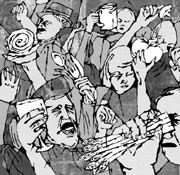THEY DON’T WEAR black (except as a fashion statement); they shun balaclavas (except on the slopes); you can’t imagine them rampaging through the streets of Genoa. But in the long run, an anarchic gaggle of gourmands calling itself Slow Food may prove a bigger threat to the McDonaldization of the world than the telegenic rock-throwers with the big A on their T-shirts.
For serious ideologues of anti- globalization, Slow Food probably counts as little more than a bad joke. It began as a joke, in fact, when an Italian journalist strolling Rome’s Spanish Steps neighborhood discovered a Big Mac outlet among its elegant shops and trattorias. Fast food, Carlo Pedrini told his readers, embodied everything antithetical to the good life, Italian style: to leisure, conviviality, the pleasures of the table.
Pedrini may have been half-kidding when he preached of the gospel of Slow Food, but the public’s response was no joke. From modest beginnings in 1986, the “movement” spread—slowly—to France, Switzerland, Germany. It leaped the Atlantic in 2000. Today Slow Food claims over 60,000 members worldwide, organized into chapters of 10 to 100 members called Convivia.
As the name suggests, the primary activity of a convivium is to get together, eat, and drink—with the proviso that what gets eaten and drunk be absolutely the best available, consumed under the most agreeable circumstances possible and over sufficient time to appreciate and celebrate it to the full.
Paradoxically, adopting Slow Food’s manifesto calling for “suitable doses of guaranteed sensual pleasure and slow, long-lasting enjoyment” leads almost directly down the path to strenuous activism. Good food is fresh food, tasty food, food free of adulterants and poisons. And it is increasingly hard to find.
Why? asked the founders of Slow Food. Because the individual orchardists and farmers and ranchers who produce it are being marginalized and driven out of business, primarily by the ever- increasing industrialization and globalization of agriculture.
If we want to eat well, the movement leaders reasoned, there must be something worth eating in the first place, and if the people who raise food worth eating are helpless to continue to do so, we must help them—by preserving farmland from development, by opposing laws and regulations favoring agribusiness over individual producers, by lobbying against the international trade in commodified foodstuffs that distorts Third World economies by destroying crop diversity and family-sustaining agriculture.
It’s no accident this movement was born in Italy, where the Catholic Church and Communism still live cheek by jowl. The institution of the convivium mirrors the central sacrament of Christianity, the solemn sharing of bread and wine among friends, while the notion of pursuing selfish pleasure for the benefit of society as a whole is a marvelous parody of the “invisible hand” of classical market economics.
Any ideology is capable of perversion. The people most likely to be drawn to the Slow Food movement are overwhelmingly likely to be leisured, well educated, and well-to-do—just the sort likely to be attracted to a program capable of salving the bad conscience attendant on a life of privilege.
BUT THE MOVEMENT’S record in Italy suggests that there, at least, gormandise, conviviality, and social action are not in conflict. Slow Food attracts tens of thousands to annual gatherings bringing together consumers and producers of artisanal foods and wines; its “Ark” program identifies endangered regional products and food species and develops programs to sustain them; its publication program issues innumerable guidebooks and checklists to aid consumers in finding producers as interested in quality as they, thereby putting food dollars where they’ll have the maximum impact for good.
All these programs have barely begun to get a toehold in North America, but progress in being made, and some powerful allies are signing on for the struggle. (Legendary restaurateur Alice Waters, for example, is heading an effort to teach Bay Area children about healthy good food by exposing them to it in their school cafeterias.)
Though Slow Food didn’t open a national office in the U.S. until last year, the movement has been active in the Seattle area—in appropriately leisurely, under-the-radar fashion—since the spring of 1998, when brewer-marketing whiz Charles Finkel was invited by a pair of luminaries in the beer world to send some of his Pike Place Ale to the biennial Slow Food exposition in Turin, Italy. Finkel and his wife, Rose Ann, accompanied the beer to the show and came back passionately committed to the cause.
This spring the Slow Food logo—a perky snail—has begun turning up on extra-Convivial events. Next week Chefshop.com, Mauny Kaseburg and Jeff Bergman’s gourmet mail-order shop on Western Avenue, is presenting the second in a series of big-name cooking events to raise the organization’s profile among Puget Sound foodies (see box below).
Slow Food’s emergence as an active player among Northwesterners dedicated to the preservation of farmland is particularly timely, with the United Nations Food and Agriculture Organization (FAO) presenting its fifth annual (and first North American) international concert and telethon at Seattle Center in the third week of October (see related article on p. 28). “Think globally; eat locally” may sound an odd slogan, but it may well prove a powerful one.








